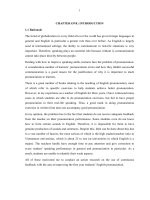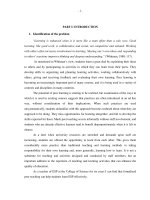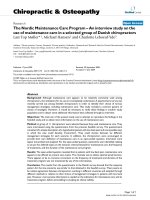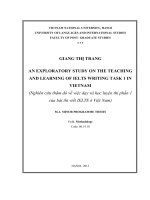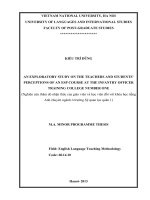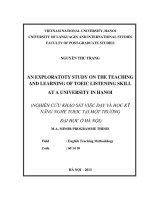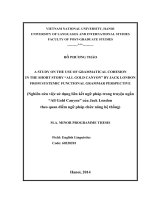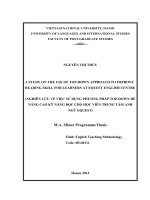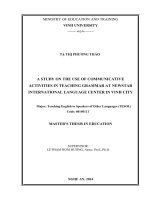An exploratory study on the use of language learning strategies by students at ULIS southern new hampshire university (USA) joint bachelor program
Bạn đang xem bản rút gọn của tài liệu. Xem và tải ngay bản đầy đủ của tài liệu tại đây (1019.59 KB, 51 trang )
VIETNAM NATIONAL UNIVERSITY, HANOI
UNIVERSITY OF LANGUAGES AND INTERNATIONAL STUDIES
FACULTY OF GRADUATE AND POSTGRADUATE STUDIES
****************************
LƯU HỒNG TRANG
AN EXPLORATORY STUDY ON
LANGUAGE LEARNING STRATEGIES USE
OF STUDENTS FROM ULIS - SOUTHERN NEW HAMPSHIRE
UNIVERSITY (USA) JOINT BACHELOR PROGRAM
Nghiên cứu thăm dò về việc sử dụng chiến lược học tập ngôn ngữ của
sinh viên chương trình đào tạo cử nhân liên kết giữa trường Đại học
Ngoại ngữ - ĐHQGHN và trường Đại học Southern New Hampshire
(Hoa Kỳ)
M.A. MINOR PROGRAMME THESIS
Field : English Teaching Methodology
Code : 60140111
HANOI – 2016
VIETNAM NATIONAL UNIVERSITY, HANOI
UNIVERSITY OF LANGUAGES AND INTERNATIONAL STUDIES
FACULTY OF GRADUATE AND POSTGRADUATE STUDIES
****************************
LƯU HỒNG TRANG
AN EXPLORATORY STUDY ON
LANGUAGE LEARNING STRATEGIES USE
OF STUDENTS FROM ULIS - SOUTHERN NEW HAMPSHIRE
UNIVERSITY (USA) JOINT BACHELOR PROGRAM
Nghiên cứu thăm dò về việc sử dụng chiến lược học tập ngôn ngữ của
sinh viên chương trình đào tạo cử nhân liên kết giữa trường Đại học
Ngoại ngữ - ĐHQGHN và trường Đại học Southern New Hampshire
(Hoa Kỳ)
M.A. MINOR PROGRAMME THESIS
Field : English Teaching Methodology
Code : 60140111
Supervisor : Dr. Ngu n Th Ngọc Quỳnh
HANOI – 2016
DECLARATION
I, Luu Hong Trang, declare that the thesis entitled “An exploratory
study on language learning strategies use of students from ULIS-Southern
New Hampshire university (USA) joint bachelor program” reports the result
of the study conducted by myself. The minor thesis is submitted to the
Faculty of Graduate and PostGraduate Studies - University of Languages and
International Studies - Vietnam National University, Hanoi for Degree of
Master in Teaching English Methodology. It has not been published
anywhere.
Hanoi, 2016
Lưu H ng Trang
i
ACKNOWLEDGEMENT
First and foremost, I would like to send my sincere thanks to my
supervisor, Dr. Nguyen Thi Ngoc Quynh, for her valuable guidance, helpful
advice, recommendation, and encouragement during the time I tried to
complete this minor thesis. Without her supervision, this work would never
have been possible.
Besides, I would like to thank all the teachers of the Faculty of
Graduate and PostGraduate Studies - University of Languages and
International Studies - Vietnam National University, Hanoi for their valuable
lectures, whose knowledge is the foundation for my thesis.
My deepest thanks also go to all students studying at the joint bachelor
program between University of Languages and International Studies and
Southern
New
Hampshire
University,
USA.
Without
their
active
participation, I would not have fulfilled this study.
Finally, I would like to express my biggest love and thanks to my
family, my close friends and my colleagues at Centre for International
Education, ULIS, VNU for their unconditional support during the time I
conducted my research. It was all of them who gave me the will to complete
this challenging work.
ii
ABSTRACT
This study examines the influence of some variables namely gender,
motivation and experience of English language learning on the use of
language learning strategies by students at the joint bachelor program between
University of Languages and International Studies, Vietnam National
University, Hanoi and Southern New Hampshire University, USA. The study
made use of guided narratives to collect demographic information from the
participants and Oxford‟s Strategy Inventory for Language Learning (SILL)
version 7.0 to determine the relationship between the variables and the
students‟ use of language learning strategies. The findings revealed that
gender difference is not one of the factors contributing to the differences in
the choices of language learning strategies. On the other hand, motivation and
experience in learning English have effect on the selection of language
learning strategies to some extent. Students with high level of motivation use
Meta-cognitive strategies with higher frequency than lowly-motivated
students. Students who do not have prior experience of learning English
reported higher use of Memory strategies than those learners with prior
experience of English learning from established language centres, specialized
language classes, or private tutorials.
iii
TABLE OF CONTENTS
DECLARATION .......................................................................................... i
ACKNOWLEDGEMENT ............................................................................. ii
ABSTRACT .................................................................................................. iii
LIST OF ABBREVIATIONS ....................................................................... vi
LIST OF TABLES
vii
CHAP 1: INTRODUCTION
vii
1.1. Statement of the problem and rationale for the study ............................ 1
1.2. Aim of the study ................................................................................... 2
1.3. Scope of the study ................................................................................ 2
1.4. Research methodology ......................................................................... 3
1.5. Organization of the study ..................................................................... 3
CHAP 2: LITERATURE REVIEW..................................................................
2.1. Language Learning Strategies (LLSs) .................................................. 4
2.1.1. Definition of learning strategies...................................................... 4
2.1.2. Classification of language learning strategies ................................. 5
2.2. Variables that Influence the Selection of Language Learning Strategies .
............................................................................................................. 6
2.2.1. Gender ............................................................................................ 6
2.2.2. Motivation ...................................................................................... 8
2.2.3. Prior Experience of the Language Learning .................................. 11
CHAPTER 3: METHODOLOGY ................................................................ 14
3.1. Setting ................................................................................................ 14
3.2. Participants ......................................................................................... 14
iv
4
3.3. Data collection instruments and procedures ........................................ 15
3.3.1. Questionnaire ............................................................................... 15
3.3.1.2. Reliability of the questionnaire .................................................. 16
3.3.2. Narratives ..................................................................................... 18
3.4. Data analysis ...................................................................................... 19
CHAP 4: RESULTS AND DISCUSSION ................................................... 21
4.1. Students‟ demographic information .................................................... 21
4.2. The Influence of Gender on the use of LLSs ...................................... 23
4.3. The Influence of Motivation on the use of LLSs................................. 24
4.4. The Influence of Experience in English Language Learning on the use
of LLSs ..................................................................................................... 25
CHAP 5: CONCLUSION............................................................................. 28
5.1. Summary of major findings ................................................................ 28
5.2. Limitations ......................................................................................... 29
5.3. Implications for language teaching and learning ................................. 29
5.4. Recommendations for Future Research .............................................. 30
REFERENCES............................................................................................. 32
APPENDIX ..................................................................................................... I
v
LIST OF ABBREVIATIONS
ULIS : University of Languages and International Studies
SNHU: Southern New Hampshire University
LLSs : Language learning strategies
SILL : Strategy Inventory for Language Learning
STEP : Society of Testing English Proficiency
vi
LIST OF TABLES
Table 1.1: Description of Gender
Table 1.2: Description of Motivation
Table 1.3: Description of Experience in learning English
Table 2.1: The use of LLSs by Gender
Table 2.2: The use of LLSs by Motivation
Table 2.3: The use of LLSs by Experience in learning English
vii
CHAP 1: INTRODUCTION
1.1. Statement of the problem and rationale for the study
University of Languages and International Studies (ULIS), Vietnam
National University, Hanoi, Vietnam has recently been rated as one of the top
universities in South East Asia for Languages and language studies at the
undergraduate level. Moreover, besides the university‟s strengths in pedagogy
and linguistic studies training for domestic students, the university is on its
way to develop international programs with various universities in the world.
Among those program highlights the joint bachelor program in Economics/
Finance between ULIS and Southern New Hampshire university, USA
(SNHU). To ensure the standards of an international program, most of the
time, the program courses are delivered fully in English language. As a result,
students‟ English language acquisition and proficiency is the key to the
success of the training program. Among significant factors contributing to the
variation in students‟ English language acquisition, language learning
strategies are believed to have great impacts. According to Meschyan and
Hernadez (2002), learning a foreign language effectively means using
adequate learning strategies. Despite this value of language learning strategies
(LLSs), no research work has been done to investigate the use of language
learning strategies by students at this joint bachelor program. Thus, the
researcher conducts this study with the hope of finding ways to better English
language proficiency of the target students by providing insights to their use
of LLSs.
1
1.2. Aim of the study
The research paper is carried out to investigate the influence of some
variables namely gender, motivation and experience of English language
learning in the use of language learning strategies by students at ULIS-SNHU
joint bachelor program.
As a result, the study addresses three main questions as follows:
1. To what extent are there significant differences in strategies used by
male and female students?
2. To what extent are there significant differences in strategies used by
highly and lowly motivated students?
3. To what extent are there significant differences in strategies used by
students with or without prior experience of learning English?
1.3. Scope of the study
As a fruitful research area of language teaching and learning, language
learning strategies has been identified to have relationship with a lot of factors
such as learners‟ proficiency, learners‟ styles, age, motivation, gender and
other individual differences. Within the limitation of a thesis paper, this study
investigates the influence of three student variables including gender,
motivation and experience of learning English in the use of language learning
strategies particularly by students enrolled in the joint bachelor program
between University of Languages and International Studies, Vietnam National
University and Southern New Hampshire University, USA.
2
1.4. Research methodology
The study employed a mixed - methods approach. Accordingly, data
was collected from a standardized questionnaire and guided narratives. The
collected data were analyzed both quantitatively and qualitatively.
1.5. Organization of the study
Chapter 1 – Introduction – deals with rationale, aim, scope and methodology
of the study
Chapter 2 – Literature review – provides the background of the study,
including definitions and classification of the key concept “language learning
strategies”, overview and summary of research on variables influence the
selection and utilization of language learning strategies namely gender,
motivation, experience of learning English.
Chapter 3 – Methodology – describes the setting, participants, instruments of
the study, as well as the procedures employed to collect and analyze the data.
Chapter 4 – Results and discussion – presents and analyzes the findings that
the researcher discovered from the data collected, and compares them with the
findings of previous studies.
Chapter 5 – Conclusion – present a summary of the major findings,
implications for language teaching and learning, limitations of the research as
well as some suggestions for further studies.
Following this chapter are the References and Appendix.
3
CHAP 2: LITERATURE REVIEW
2.1. Language Learning Strategies (LLSs)
2.1.1. Definitions of learning strategies
Up to now there is still no agreed definition of language learning
strategies; however, most researchers define learning strategies as learners‟
actions and/ or behaviors to facilitate the learning process.
Rubin (1975: 43) defines learning strategies as learners‟ techniques or
devices to acquire knowledge. Wenden (1998) clarifies the definition by
affirming that learning strategies are “mental steps or operations that learners
use to learn a new language and to regulate their efforts to do so” (p.18).
More specifically, Richards and Schmidt (2002: 9, cited in Olga, 2003)
consider learning strategies as “the different ways in which learners try to
understand the grammar, meanings and uses, and other aspects of the
language they are learning”.
O‟Malley and Chamot share the same idea regarding learning strategies
as: “the special thoughts or behaviors that individuals use to help them
comprehend, learn, or retain new information. ... Learning strategies are
special ways of processing information that enhance comprehension, learning,
or retention of the information.”
(O‟Malley and Chamot, 1990, p.1)
In this study, the researcher adopts the definition given by Oxford
(2001) that learning strategies are mental operations used by learners to aid
the acquisition, storage, retrieval, and use of information; and specific
actions taken by learners to facilitate their learning process.
4
2.1.2. Classification of language learning strategies
Throughout the history of researching learning strategies, various
models of categorizing learning strategies have been developed; however, the
researcher chooses to carry out the study basing on Rebecca L. Oxford‟s
framework (1990). A lot of scholars (Ellis, 1994; Jones, 1998; Bremner,
1999) consider Oxford‟s model as the most comprehensive and detailed
classification of learning strategies to date compared to other models where
most of the factors are overlapping.
In Oxford‟s framework, learning strategies are classified into two sets
of taxonomy: „Direct strategies‟ and „Indirect strategies‟.
Direct strategies include memory strategies, cognitive strategies and
compensation strategies which “involve direct learning and use of the subject
matter” (Oxford, 1990, p.12) and “require mental processing of the language”
(Oxford ,1990, p.37).
Memory strategies are the methods particularly customized in
order to support learners so that they can become able to store
fresh data in the memory and recover the data when needed at a
later period (Magogwe & Oliver, 2007).
Cognitive strategies consist of the abilities which permit the
learners to approach, appreciate and create dialect or the targeted
language by various diverse means.
Compensation strategies refer to the collection of practices or
behavioral characteristics that are utilized in order to compensate
as well as to support the learners so that they can easily and
comprehensively utilize the targeted language.
5
On the other hand, indirect strategies are those techniques which
“support and manage language learning without (in many instances) directly
involving the target language” (Oxford, 1990, p.135). Indirect strategies can
also be divided into three distinctive forms namely meta-cognitive strategies,
affective strategies, and social strategies.
Meta-cognitive strategies include those behavioral characteristics
that are utilized in order to make organization, preparation,
systematic planning, and assessment of the learning progress of a
learner (Rahimi & Katal, 2012).
Affective strategies comprise of the methods which are utilized in
the process of regulating the behavioral characteristics associated
with the aspects of emotion and motivational dimension.
Social strategies include those techniques that support and
provide helping systems to a learner in order to make him or her
more capable of more comprehensively and adequately
interacting with other people during the entire duration or system
of the acquisition of the targeted language (Akyol, 2013).
2.2. Variables that Influence the Selection of Language Learning
Strategies
2.2.1. Gender
It has been clarified through the findings of various research that
among a few elements or influencing variables, for example, motivation, age,
standard of proficiency, prior knowledge or experience and many others, the
aspect of gender has been considered to be extensively examined in regards to
the impact of the variables on the learning of a second or foreign language
6
(e.g. Goh & Foong, 1997; Gu, 2002; Chamot & Keatley, 2004; Hong-Nam &
Leavell, 2006).
It should be noted that various studies have reported that female
learners demonstrated essentially more use of learning techniques than male
learners (e.g. Goh & Foong, 1997; Green & Oxford, 1995; Gu, 2002; Hakan,
Aydin, & Bulent, 2015). A number of studies have built up the presence of
gender difference to be a critical factor in the utilization of LLSs (e.g. Ehrman
& Oxford, 1995; Peacock & Ho, 2003; Xue, 2015). Ehrman and Oxford
(1995) studied both language learners and teachers in an exploratory study of
gender influence on the use of LLSs by adult learners and found out that
female learners accounted for more strategy use than their male counterparts,
especially in the application of Social strategies. Recently, Xue (2015)
examined the impacts of gender on the selection of language learning
strategies by 102 Chinese ESL (English for a second language) students in a
British university. Female students in that study reported more frequent use of
LLSs than male, particularly Cognitive, Meta-cognitive and Social strategies.
On the contrary, numerous studies revealed that male learners were the
one used language learning strategies with greater frequency than females.
For example, Wharton (2000) conducted a research of nearly 700 students in
Singapore learning Japanese and French as foreign languages regarding their
language learning strategies and affective factors. That study indicated factors
influence students‟ language learning including age, motivation, cultural
background, language studied, learning style, prior language learning
experience, language learning goals and types, numbers and frequency use of
LLSs. More specifically, with regards to difference in gender, the results of
the research work demonstrated that male learners showed a tendency to
7
employ more use of LLSs both in terms of quantities of strategies and
frequency of strategies use. This finding confirmed Tran‟s (1988) observation
of Vietnamese refugees that male learners tend to use a greater number of
LLSs than their female counterparts.
On the other hand, other studies of various national backgrounds
indicated that the aspect of gender might not be one of the main factors that
influence the choice of students‟ language learning strategies. For example,
Griffiths (2003) used Oxford‟s Strategy Inventory for Language Learning
(SILL) to study the relationship between strategy use and course level of 348
learners. Despite this relationship was found, there was proved to be little or
no effect of gender and age on the choice of LLSs. Nisbet et. al. (2005)
investigated the relationship between LLSs preferences and English
proficiency among 168 Chinese university students to find out that there were
no significant differences between male and female groups in terms of
strategy preferences and language proficiency.
Despite numerous studies have examined the relationship between
language learning strategies of ESL learners and gender difference, this
correlation is not explicit as previous studies revealed conflicting results.
Under the light of this fact, it is highly recommended that experts should
conduct more research to determine the effect of the aspect of gender on the
utilization of language learning strategies.
2.2.2. Motivation
In language learning strategies research, studies on the relationship
between language learning strategies and affective factors such as motivation
have expanded to a huge extent. Gardner (1985) asserted that motivation and
attitudes are the primary factors affecting individual language learning. Four
8
components of motivation were described including a goal, effort, want and
attitudes toward language learning.
One popular classification of motivation divides two different types
namely integrative motivation and instrumental motivation (Ungureanu &
Georgescu, 2012). The first type of motivation refers to learners‟ desire to
integrate themselves into cultures and societies of English speaking countries
(Wong & Nunan, 2011). Motivation of instrumental orientation; whereas,
deals with learners‟ personal practical goals such as successful in certain
examinations or achieving a certain work position. It was inferred that both
the instrumental and the integrative aspects, prompt to a higher level of
expertise or capacity. However, the integrative aspect inspired and enhanced
the learners to acquire the targeted language more easily and expertly
(Gardner and MacIntyre, 1993).
For the most part, the aspect of the motivation should be considered as
a matter which discloses the reasons behind why individuals choose to
accomplish a specific thing, to what extent individuals have a will to maintain
various activities and how much effort they would put in such activities to
achieve their goals (Dörnyei, 2001). Accordingly, a number of research works
demonstrated that students occupied with a great level of inspiration or
motivational orientation during the process of acquiring a language would
probably utilize a variety of effective strategies or procedures (Oxford and
Nyikos, 1989). In this way, as far as the acquisition of the language is
concerned, the level of the accomplishment may be considered as one of the
most important components of motivation because this aspect can prompt to
and bolster every kind of exercises or tasks.
9
As the aspect of motivation is regarded as an essential component
contributing to the success of language learning, researchers have paid a lot of
attention to learners‟ challenges in the teaching and learning environments.
As a result, a lot of effort has been made to investigate the relationship
between the aspect of motivation and language learning strategies. According
to Pintrich and Schunk‟s study (2002), motivation has an influence on
forming new attitudes to the learning process as well as affects how prior
learned behaviors are performed. Mochizuki (1999) conducted a study on 157
Japanese students of at a state-run university in Japan to investigate the kinds
of language learning strategies used by Japanese students, factors affecting
the choices of language learning strategies, as well as the reliability of the
learner's self-evaluation of English proficiency. With data collected from the
use of Oxford‟s 80 item Strategy Inventory for Language Learning (SILL)
and the results from Japanese Second Grade Test of the Society of Testing
English Proficiency (STEP), the researcher found out that Compensation
strategies were used with the highest frequency and Affective strategies were
used with the lowest frequency among Japanese students. The research also
indicated that among several factors that affected Japanese students‟ choice of
strategies such as major, motivation, enjoyment of English learning and
gender, the aspect of motivation accounted for the most important factor.
Another study also in the Japanese context examined the relationship
between learners‟ personal factors and their choices of language learning
strategies (Tamada, 1996). Results indicate that with regards to motivation,
center learning and evaluating learning strategies affected learning strategy
use. The research also revealed that among different learners‟ personal
factors, while learners‟ major, personality and proficiency did not influence
the choices of learning strategies, gender, integrative motivation and
10
instrumental motivation had significant effect. It is also noteworthy that
another factor affecting selections of Japanese students‟ language learning
strategies found out in this study was experiences of both studying and living
abroad.
Nevertheless, it should be noted that the aspect of motivation in the
Japanese context is somewhat specific while focusing on integrative
motivation such as learners‟ want to travel abroad and make international
friends. According to Irie (2003) and Yashima (2000), the primary focus is
not on instrumental elements such as grades at school or future job positions.
As there is still little research on motivation and language learning strategies
in the Vietnamese context, further research in this area is needed.
2.2.3. Prior Experience of Language Learning
The aspect of having prior experience of language learning is likewise
considered as one of the most important variables and it has also been
asserted that this variable may influence the selection of LLSs. (Gerami &
Baighlou, 2011). Notwithstanding, there is not a huge base of research works
that have been conducted in order to examine the relationship between prior
experience of English learning and the utilization of LLSs.
One study extensively investigated the procedures of LLSs utilization
developed by those children who were not only eligible for going to schools
but also had the capability to speak in two different languages (Purdie and
Oliver, 1999). These children mainly originated from three distinctive major
orientations of cultures namely the Asians (this group mainly consisted of
those children who could speak in the native tongue of Vietnam or China), the
Europeans (this group did not only consist of those children who were able to
speak in the native language of Greece but also had some individuals who
11
could speak the native language of Macedonia), and the final group which
consisted of those people who could speak in the native language of Arab.
The outcomes of the research demonstrated that the learners who stayed in
Australia for a considerable duration succeeded to essentially achieve greater
mean values associated with Cognitive strategies as well as Memory
techniques. The results of the research, subsequently, show that having prior
experience of language learning may have an immense influence on the
selection or preference of LLSs.
The above-mentioned study significantly points out the significance of
having prior experience of language learning as one of those key components
that have a considerable influence on the selections of LLSs. The results
obtained by the above-mentioned research additionally supported the findings
of a study conducted in 1990 by the group of three well-known researchers
namely Opper, Teichler, and Carlson. This study concentrated on the aspect
of having an experience regarding learning through collaborative projects
with foreign settings within Europe as well as the USA. The outcomes of that
study demonstrated that learning in foreign settings should be considered to
have a significant level of impact on students‟ thought and learning style,
particularly regarding learners‟ capacity to acquire a language in a
comprehensive manner (Opper, Teichler, and Carlson, 1990). The study also
hinted that various other affective factors on learners such as academic level,
foreign language proficiency, cultural background, attitude and view changes
were likewise demonstrated as the components that have contribution in the
selection of LLSs. The results of the study are consistent with the findings
generated by Oxford through a research work conducted in 1996. Oxford‟
study revealed that one had to consider several different variables including
cultural background and nationality that may produce a significant level of
12
impact on the choice of LLSs. Be that as it may, investigating the impacts of
studying or staying in a foreign country to language learning strategies, the
researchers have figured out the importance of having prior experience of
language learning to the selection of LLSs (Lavasani & Faryadres, 2011).
13
CHAPTER 3: METHODOLOGY
3.1. Setting
The subjects of this study are students enrolled in the joint bachelor
program majoring in Economics – Finance between University of Languages
and International Studies, Vietnam National University, Hanoi (ULIS) and
Southern New Hampshire University, USA (SNHU). The format of the
program is that the first two year major courses are delivered by ULIS both in
Vietnamese and English language. In addition to the SNHU modeled
curriculum for Economics – Finance major, during these first two years,
students get additional training in English to ensure their English proficiency
for the second two years. Upon completion of the first two years, students will
be admitted to the second two years which is a full SNHU program totally
delivered in English only when meeting an academic GPA of 2.0 and English
proficiency equivalent to 530 TOEFL ITP/ 71 TOEFL IBT or 6.0 IELTS.
3.2. Participants
The questionnaire and guided narrative used in this study was sent to
206 students currently enrolled in the program. To ensure rich information,
the researcher chose participants from all current classes (freshmen,
sophomores, juniors and seniors). 144 students of all those classes returned
their responses completed fully so this is the exact number of the participants.
By the time of this study, all participants had received a minimum of 3 years
of English as a foreign language as a compulsory subject at high school and at
least 5 months of intensive English training at university. Their English
proficiency ranges from Elementary to Advanced level.
14
3.3. Data collection instruments and procedures
This study uses a mixed-method approach. Data were collected from a
standardized Likert-scale based questionnaire and guided narratives. As
suggested by Griffiths and İnceçay (2016), “a mixed-method approach can
contribute to a fuller understanding of the strategy phenomenon by
approaching it from different perspectives.” (p. 34).
3.3.1. Questionnaire
3.3.1.1. Description of the questionnaire
With a view to measure learning strategy preferences of students of the
ULIS-SNHU program, the researcher used Oxford‟s Strategy Inventory for
Language Learning (SILL) version 7.0 (1989). The SILL, which has been
developed with various versions from 1986, is a summative rating scale
designed to assess the frequency of use of language learning strategies by
learners of English as a foreign language.
The SILL consists of 50 items with six categories measuring six types
of learning strategies: memory strategies (9 items), cognitive strategies (14
items), compensation strategies (6 items), metacognitive strategies (9 items),
affective strategies (6 items), and social strategies (6 items). Each part
consists of statements about strategies used by language learners such as “I
say or write new words in English several times” or “I look for words in my
own language that are similar to new words in English several times” with a
5-point Likert type scale: (1) Never or almost never true of me; (2) Usually
not true of me; (3) Somewhat true of me; (4) Usually true of me; (5) Always
or almost always true of me.
15
Oxford (1990) has also offered the instruction to compute and interpret
the scores following the 50 strategy descriptions. The frequency of use of
LLSs can be grouped into three levels based on the overall averages from the
results: high frequency (3.5–5.0), medium frequency (2.5–3.4), and low
frequency (1.0–2.4).
3.3.1.2. Reliability of the questionnaire
The researcher chose the SILL questionnaire as the primary data
collection for the study firstly because the usefulness of a self-report
questionnaire. McDonough (1997, p. 171) asserted that this type of
questionnaire can afford a good deal of precision and clarity as the knowledge
needed is controlled by the questions. Particularly, when discussing
advantages of strategy questionnaires such as SILL, Oxford (1992, p.33, cited
in Griffiths 2003, p.56) considered them as “the most cost-effective mode of
strategy assessment, and are almost completely non-threatening when
administered using paper and pencil (or computer) under conditions of
confidentiality.” In fact, this assessment tool, SILL, is currently recognized as
the most comprehensive and widely used instrument for identifying strategy
preferences of language learners throughout the world with the reliability
level ranging from .93 to .98 (Green & Oxford, 1995).
3.3.1.3. Questionnaire procedure
The SILL questionnaire was not translated into Vietnamese to avoid
unexpected misunderstanding, especially possible misinterpretation of
technical terms. In addition, despite the diversity of English proficiency
levels, the respondents were expected to be proficient enough to understand
the strategy statements.
16
